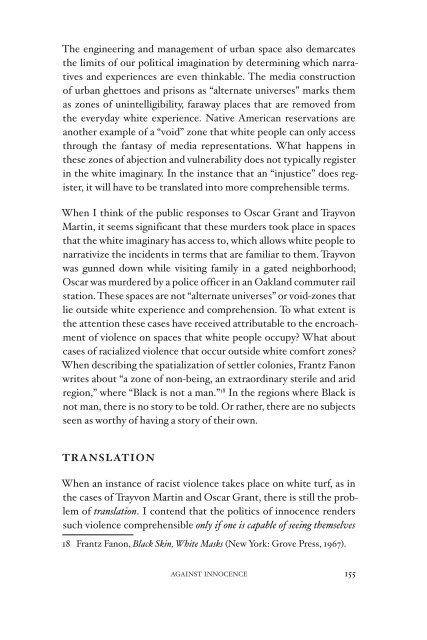Lies: A Journal of Materialist Feminism - Libcom
Lies: A Journal of Materialist Feminism - Libcom
Lies: A Journal of Materialist Feminism - Libcom
You also want an ePaper? Increase the reach of your titles
YUMPU automatically turns print PDFs into web optimized ePapers that Google loves.
The engineering and management <strong>of</strong> urban space also demarcates<br />
the limits <strong>of</strong> our political imagination by determining which narratives<br />
and experiences are even thinkable. The media construction<br />
<strong>of</strong> urban ghettoes and prisons as “alternate universes” marks them<br />
as zones <strong>of</strong> unintelligibility, faraway places that are removed from<br />
the everyday white experience. Native American reservations are<br />
another example <strong>of</strong> a “void” zone that white people can only access<br />
through the fantasy <strong>of</strong> media representations. What happens in<br />
these zones <strong>of</strong> abjection and vulnerability does not typically register<br />
in the white imaginary. In the instance that an “injustice” does register,<br />
it will have to be translated into more comprehensible terms.<br />
When I think <strong>of</strong> the public responses to Oscar Grant and Trayvon<br />
Martin, it seems significant that these murders took place in spaces<br />
that the white imaginary has access to, which allows white people to<br />
narrativize the incidents in terms that are familiar to them. Trayvon<br />
was gunned down while visiting family in a gated neighborhood;<br />
Oscar was murdered by a police <strong>of</strong>ficer in an Oakland commuter rail<br />
station. These spaces are not “alternate universes” or void-zones that<br />
lie outside white experience and comprehension. To what extent is<br />
the attention these cases have received attributable to the encroachment<br />
<strong>of</strong> violence on spaces that white people occupy? What about<br />
cases <strong>of</strong> racialized violence that occur outside white comfort zones?<br />
When describing the spatialization <strong>of</strong> settler colonies, Frantz Fanon<br />
writes about “a zone <strong>of</strong> non-being, an extraordinary sterile and arid<br />
region,” where “Black is not a man.” 18 In the regions where Black is<br />
not man, there is no story to be told. Or rather, there are no subjects<br />
seen as worthy <strong>of</strong> having a story <strong>of</strong> their own.<br />
TRANSLATION<br />
When an instance <strong>of</strong> racist violence takes place on white turf, as in<br />
the cases <strong>of</strong> Trayvon Martin and Oscar Grant, there is still the problem<br />
<strong>of</strong> translation. I contend that the politics <strong>of</strong> innocence renders<br />
such violence comprehensible only if one is capable <strong>of</strong> seeing themselves<br />
18 Frantz Fanon, Black Skin, White Masks (New York: Grove Press, 1967).<br />
AGAINST INNOCENCE 155

















